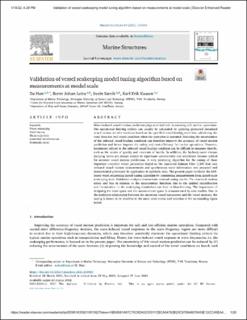| dc.contributor.author | Han, Xu | |
| dc.contributor.author | Leira, Bernt Johan | |
| dc.contributor.author | Sævik, Svein | |
| dc.contributor.author | Kaasen, Karl Erik | |
| dc.date.accessioned | 2022-03-31T13:13:35Z | |
| dc.date.available | 2022-03-31T13:13:35Z | |
| dc.date.created | 2021-10-12T13:43:16Z | |
| dc.date.issued | 2021 | |
| dc.identifier.citation | Marine Structures. 2021, 80 . | en_US |
| dc.identifier.issn | 0951-8339 | |
| dc.identifier.uri | https://hdl.handle.net/11250/2988901 | |
| dc.description.abstract | Wave-induced vessel motion prediction plays a critical role in ensuring safe marine operations. The operational limiting criteria can usually be calculated by applying presumed linearized vessel motion transfer functions based on the specified vessel loading condition, which may deviate from the real vessel condition when the operation is executed. Reducing the uncertainties of the onboard vessel loading condition can therefore improve the accuracy of vessel motion prediction and hence improve the safety and cost-efficiency for marine operations. However, parameters related to the onboard vessel loading condition can be difficult to measure directly, such as the center of gravity and moments of inertia. In addition, the hydrodynamic viscous damping terms are always subject to significant uncertainties and sometimes become critical for accurate vessel motion predictions. A very promising algorithm for the tuning of these important uncertain vessel parameters based on the unscented Kalman filter (UKF) that uses onboard vessel motion measurements and synchronous wave information was proposed and demonstrated previously by application to synthetic data. The present paper validates the UKF-based vessel seakeeping model tuning algorithm by considering measurements from model-scale seakeeping tests. Validation analyses demonstrate rational tuning results. The observed random errors and bias in relation to the measurement functions due to the applied simplification and linearization in the seakeeping simulations can lead to biased tuning. The importance of designing the state space and the measurement space is demonstrated by case studies. Due to the nonlinear relationship between the uncertain vessel parameters and the vessel motions, the tuning is shown to be sensitive to the mean state vector and selection of the surrounding sigma points. | en_US |
| dc.language.iso | eng | en_US |
| dc.publisher | Elsevier | en_US |
| dc.rights | Navngivelse 4.0 Internasjonal | * |
| dc.rights.uri | http://creativecommons.org/licenses/by/4.0/deed.no | * |
| dc.subject | Systematic errors | en_US |
| dc.subject | Unscented transformation | en_US |
| dc.subject | Model-scale tests | en_US |
| dc.subject | Model tuning | en_US |
| dc.subject | Vessel seakeeping | en_US |
| dc.title | Validation of vessel seakeeping model tuning algorithm based on measurements at model scale | en_US |
| dc.type | Peer reviewed | en_US |
| dc.type | Journal article | en_US |
| dc.description.version | publishedVersion | en_US |
| dc.rights.holder | © 2021 The Authors. Published by Elsevier Ltd. | en_US |
| dc.source.pagenumber | 26 | en_US |
| dc.source.volume | 80 | en_US |
| dc.source.journal | Marine Structures | en_US |
| dc.identifier.doi | 10.1016/j.marstruc.2021.103083 | |
| dc.identifier.cristin | 1945281 | |
| dc.relation.project | Norges forskningsråd: 237929 | en_US |
| dc.source.articlenumber | 103083 | en_US |
| cristin.ispublished | true | |
| cristin.fulltext | original | |
| cristin.fulltext | postprint | |
| cristin.qualitycode | 2 | |

